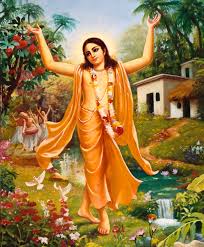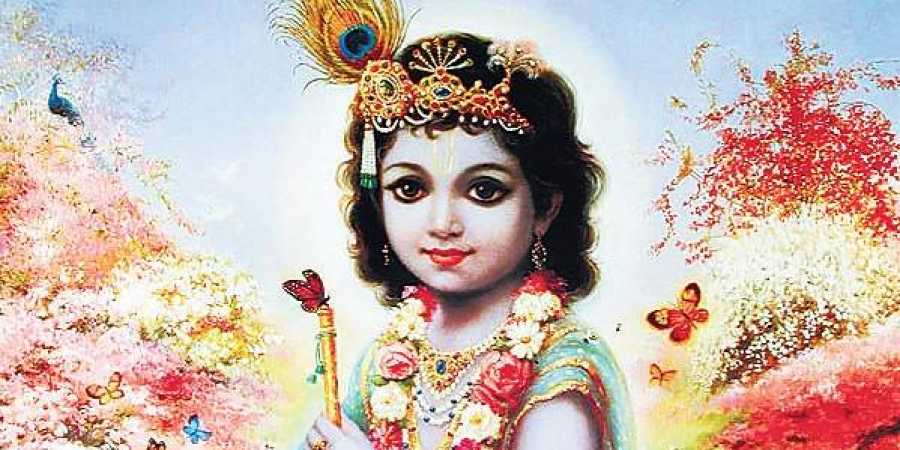|
Sri Chaitanya Mahaprabhu was born at Mayapur near Navaidip, district Nadia (75 miles from Kolkata) West Bengal, who lived during 1486-1533. He was from Bengali Brahmin family. At sixteen, he was youngest professor in Nadia who attracted large numbers of students. He also challenged other scholars to debates in East Bengal and turned victorious.
Incarnation of Sri Krishna: He is considered an avatar of Lord Krishna by his followers. Many supernatural phenomena were seen manifesting on the boy’s body. While sleeping a moon like aura was sometimes found floating over him and in his bed room many luminous figures appeared before his mother. He is believed to be Radha and Krishna came in one body. Initiation for Worship of Radha-Krishna: When he was around twenty years, he undertook a pilgrimage to Gaya, to perform pinda-rites for the salvation of his ancestors. After pida-rites, when worshipped at Vishnu-pada, he fell into trance. When he fell, an ascetic Isvara Puri supported him. After coming to normalcy, Sri Chaitanya requested Puri to help him realize a glimpse of Radha’s love for Sri Krishna. Isvara Puri initiated him into the Mantra for Sri Krishna worship. Immediately after initiation, his jovial mood was transformed into sorrowful mood. His soul tossed from sorrow to ecstasy and from ecstasy to sorrow. Start of Sri Krishna Sankirtan: After return from Gaya, he fell into trance a number of times and developed religious ecstasy. He failed to teach the students. Then he proposed to start Sri Krishna kirtan. The eight expressions of intense God-love – weeping, shivering, sweating, horripilation, fainting etc. – began to manifest in him. Such external manifestations of the onset of Sri Krishna prema were sometimes very uncontrollable and turbulent in nature. Once, he behaved strangely and declared himself as deity. He and his followers started Sri Krishna Kirtans (Har Bol) from door to door to spread Sri Krishna bhakti. When he was twenty four, the Radha mood began possess him more. He had taught Bhakti till then and now he wanted to teach Prema (intense love) by his own example. In Radha mood he began to heave sighs of longing, and manifest agonizing pangs of separation and collapsing. Pilgrimage to Jagannath Puri: He madly longed to go to Vrindavan. For five days he walked without food or rest through fields and forests and lost the way. He reached the residence of a Advaita Acharya at Santipur who persuaded him to go to Jagannath Puri. After reaching Puri temple, he rushed like one frenzied towards the image to embrace Jagannath and in the process fell down. There he met Pandit Vasudeva Sarvabhauma in Puri who advised Chaitanya that he was too young to be ascetic, that his devotional fervor, singing, dancing etc. were mere eccentricities and aberrations, and that he should now learn Vedanta under him. Chaitanya accepted the proposal. During taking lessons, the Pandit asked whether he was following his exposition, and got the shocking reply that Vedanta text was itself simple enough for him to understand, but he could not understand even a word of Shankara’s commentary. Then for a verse from Bhagavad Gita, the Pandit gave nine meanings, Chaitanya gave many more. Then the Pandit declared him full of Vedic wisdom. The Pandit surrendered himself to Chaitanya and prostrated at his feet. When he got up and looked, he saw six armed divinity instead Chaitanya. The sight put him into a state of rapt Samadhi. Next day, Chaitanya told him: the law of Prema-Bhakti is as Radha had sung: “Listen! The flute my beloved is beckoning me. I must go. My beloved cannot be won without sacrifice. If you desire to capture Him, you must first surrender everything to Him.” Pilgrimage along Eastern Coast, Southern & Western Parts of India: Sri Chaitanya travelled along east coast to south up to Kanyakumari and visited several places such as Rajamundri near east Godavari, Kanyakumari, Madurai, Udupi (seat of Madhacharya’s religion), etc. He then passed through western and middle regions of India where he visited the famous Pandarpur in Maharashtra, Dwarka, etc. Then he travelled towards Puri passing through many holy places along the banks of Tapti, Narmada and Godavari. After the stay of three years at Puri, he left Puri and proceeded for Vrindavan. On the way, he stayed at Varanasi, Prayaga and Mathura. After a few months stay in Vrindavan, he returned to Prayaga. He converted a large number of Mohammedans not by the scriptures of Vaishnavism but by argument from the Quran. The descendants of those converts are still known as Pathan Vaishnavas. Return to Puri: Sri Chaitanya returned Puri from Prayag. He continued to stay at Puri for eighteen years, until His disappearance in His forty-eighth year at the time of Sankirtan in the temple of Tota Gopinath. During these 18 years, His life was one of settled love and piety. He was surrounded by numerous followers, all of whom were of the highest order of the Vaishnavas having spiritual love in Radha-Krishna. His Teachings:
Reference: Bhakti Schools of Vedanta – by Swami Tapasyananda, Sri Ramakrishna Math, Chennai.
1 Comment
“Krushnam vande jagat gurum” means I bow to Krishna, the teacher of the world.
Shri Krishna is historical figure and the Purnaavtara (complete incarnation) who appeared in this world on 18th July, 3102 BC, in the last part of Dwapar Yuga of 28th Manyavantra (around 5122 years ago). He appeared before Ma Devaki as four armed Vishnu at mid-night, Sravani Krishna Astami. The Vishnu Purana stated that it was a dreadful night with heavy rain and violent wind. He was 8th incarnation (Avatar) of Vishnu Bhagwan. He lived and died for the fellow human beings. He shared the joys and sorrows of kings and commoners alike. Not only he transmitted the wisdom of Upanishads & Vedas in form of Bhagavad Gita, but His life was also lessons on bhakti yoga, karma yoga, jnana yoga and Raja Yoga. The four dimensional perspective of His personality has been attempted in this article. No scripture could recount the entire life of Shri Krishna. It is told primarily through Srimad Bhagavatam, Garga Samhita, Visnu Purana, Brahmavaivarta Purana, Mahabharata, Harivamsa and several other puranas. Why called as Purnaavtara (complete incarnation of the almighty): Shri Krishna proclaimed himself as Almighty and liberated many during his lifetime. He performed several humanly impossible tasks, showed Virat form and extra-ordinary qualities.
Shri Krishna is a perfect personification of divinity. He was a revolutionary of his time. He accomplished the protection of feeble & gentle, destruction of evil-doers and installation dharma. He believed that whenever popular righteous is in opposition, one should follow the higher cause of dharma. He is symbol of compassion, tenderness, love, destroyer of evil-doers, perfect in his different roles, man of wisdom and above all yogeshwar.
|
Archives
May 2024
Categories |


 RSS Feed
RSS Feed